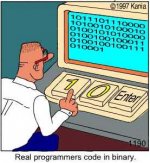per
Veteran Member
Yah! Today I wrote my first Assembly Program (8086/8088 ASM)! :D It's not a big program, only 300 bytes, but it reads inputs and writes outputs. The program does:
1 Clear the entire screen and hide cursor
2 Waits for a keypress, i'ts using the scan and character code for random number seed.
3 Generates a random double word.
4 Using the random data to output a character on the top line.
5 Scrolls the entire screen one line downwards.
6 Runs through a speed regulating loop routine.
7 Returns to step 3 if no key is pressed.
8 Restore system defaults and return to DOS.
The program is supposed to run on a PC system with MDA and an IBM 5151 monitor. The effect of this program is a "The Matrix" like screensaver.
What is the first thing you have made in Assembly.
1 Clear the entire screen and hide cursor
2 Waits for a keypress, i'ts using the scan and character code for random number seed.
3 Generates a random double word.
4 Using the random data to output a character on the top line.
5 Scrolls the entire screen one line downwards.
6 Runs through a speed regulating loop routine.
7 Returns to step 3 if no key is pressed.
8 Restore system defaults and return to DOS.
The program is supposed to run on a PC system with MDA and an IBM 5151 monitor. The effect of this program is a "The Matrix" like screensaver.
What is the first thing you have made in Assembly.

